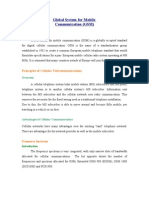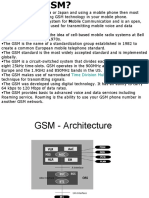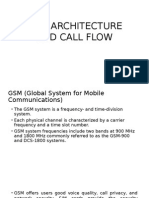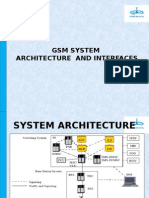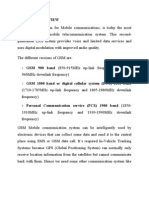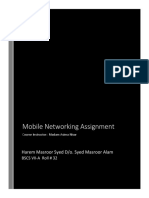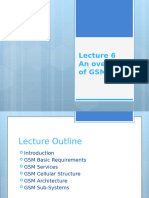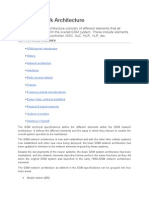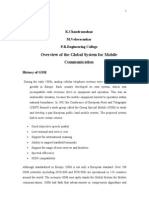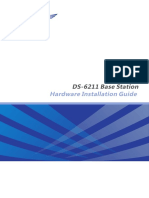Global System For Mobile Communication (GSM)
Global System For Mobile Communication (GSM)
Uploaded by
RobertoCopyright:
Available Formats
Global System For Mobile Communication (GSM)
Global System For Mobile Communication (GSM)
Uploaded by
RobertoOriginal Title
Copyright
Available Formats
Share this document
Did you find this document useful?
Is this content inappropriate?
Copyright:
Available Formats
Global System For Mobile Communication (GSM)
Global System For Mobile Communication (GSM)
Uploaded by
RobertoCopyright:
Available Formats
- The Home Location Register (HLR) is the main database of permanent subscriber information for a mobile network.
The HLR is an integral component of CDMA (code division multiple access), TDMA (time division multiple access), and GSM (Global System for Mobile communications) networks. Maintained by the subscriber's home carrier (or the network operator where the user initiated the call), the HLR contains pertinent user information, including address, account status, and preferences. The HLR interacts with the Mobile Switching Center (MSC), which is a switch used for call control and processing. The MSC also serves as a point-of-access to the Public Switched Telephone Network (PSTN - the fixed network). The third integral element is the Visiting Location Register (VLR), which maintains temporary user information (such as current location) to manage requests from subscribers who are out of the area covered by their home system. When a user initiates a call, the switching equipment determines whether or not the call is coming from the device's home area. If the user is out of the home area, the area VLR sends out a request for information required to process the call. An MSC queries the HLR identified by the call for information, which it relays to the appropriate MSC, which in turn relays it to the VLR. The VLR sends routing information back to the MSC which allows it to find the station where the call originated, and, finally, the mobile device to connect. Communications between the elements are based on Signaling System (SS7) protocols and signaling.
Global System for Mobile Communication (GSM)
Table of Contents:
Definition and Overview 1. Introduction: The Evolution of Mobile Telephone Systems 2. GSM 3. The GSM Network 4. GSM Network Areas 5. GSM Specifications 6. GSM Subscriber Services Self-Test Glossary PDF of this tutorial
3. The GSM Network
GSM provides recommendations, not requirements. The GSM specifications define the functions and interface requirements in detail but do not address the hardware. The reason for this is to limit the designers as little as possible but still to make it possible for the operators to buy equipment from different suppliers. The GSM network is divided into three major systems: the switching system (SS), the base station system (BSS), and the operation and support system (OSS). The basic GSM network elements are shown in Figure 2.
Figure 2. GSM Network Elements
The Switching System The switching system (SS) is responsible for performing call processing and subscriber-related functions. The switching system includes the following functional units.
home location register (HLR)The HLR is a database used for storage and management of subscriptions. The HLR is considered the most important database, as it stores permanent data about subscribers, including a subscriber's service profile, location information, and activity status. When an individual buys a subscription from one of the PCS operators, he or she is registered in the HLR of that operator. mobile services switching center (MSC)The MSC performs the telephony switching functions of the system. It controls calls to and from other telephone and data systems. It also performs such functions as toll ticketing, network interfacing, common channel signaling, and others. visitor location register (VLR)The VLR is a database that contains temporary information about subscribers that is needed by the MSC in order to service visiting subscribers. The VLR is always integrated with the MSC. When a mobile station roams into a new MSC area, the VLR connected to that MSC will request data about the mobile station from the HLR. Later, if the mobile station makes a call, the VLR will have the information needed for call setup without having to interrogate the HLR each time.
authentication center (AUC)A unit called the AUC provides authentication and encryption parameters that verify the user's identity and ensure the confidentiality of each call. The AUC protects network operators from different types of fraud found in today's cellular world. equipment identity register (EIR)The EIR is a database that contains information about the identity of mobile equipment that prevents calls from stolen, unauthorized, or defective mobile stations. The AUC and EIR are implemented as stand-alone nodes or as a combined AUC/EIR node.
The Base Station System (BSS) All radio-related functions are performed in the BSS, which consists of base station controllers (BSCs) and the base transceiver stations (BTSs).
BSCThe BSC provides all the control functions and physical links between the MSC and BTS. It is a high-capacity switch that provides functions such as handover, cell configuration data, and control of radio frequency (RF) power levels in base transceiver stations. A number of BSCs are served by an MSC. BTSThe BTS handles the radio interface to the mobile station. The BTS is the radio equipment (transceivers and antennas) needed to service each cell in the network. A group of BTSs are controlled by a BSC.
The Operation and Support System The operations and maintenance center (OMC) is connected to all equipment in the switching system and to the BSC. The implementation of OMC is called the operation and support system (OSS). The OSS is the functional entity from which the network operator monitors and controls the system. The purpose of OSS is to offer the customer cost-effective support for centralized, regional, and local operational and maintenance activities that are required for a GSM network. An important function of OSS is to provide a network overview and support the maintenance activities of different operation and maintenance organizations. Additional Functional Elements Other functional elements shown in Figure 2 are as follows:
message center (MXE)The MXE is a node that provides integrated voice, fax, and data messaging. Specifically, the MXE handles short message service, cell broadcast, voice mail, fax mail, e-mail, and notification. mobile service node (MSN)The MSN is the node that handles the mobile intelligent network (IN) services. gateway mobile services switching center (GMSC)A gateway is a node used to interconnect two networks. The gateway is often implemented in an MSC. The MSC is then referred to as the GMSC. GSM interworking unit (GIWU)The GIWU consists of both hardware and software that provides an interface to various networks for data communications. Through the GIWU, users can alternate between speech and data during the same call. The GIWU hardware equipment is physically located at the MSC/VLR.
Global System for Mobile Communication (GSM)
Table of Contents:
Definition and Overview 1. Introduction: The Evolution of Mobile Telephone Systems 2. GSM 3. The GSM Network 4. GSM Network Areas 5. GSM Specifications 6. GSM Subscriber Services Self-Test Glossary PDF of this tutorial
4. GSM Network Areas
The GSM network is made up of geographic areas. As shown in Figure 3, these areas include cells, location areas (LAs), MSC/VLR service areas, and public land mobile network (PLMN) areas.
Figure 3. Network Areas
The cell is the area given radio coverage by one base transceiver station. The GSM network identifies each cell via the cell global identity (CGI) number assigned to each cell. The location area is a group of cells. It is the area in which the subscriber is paged. Each LA is served by one or more base station controllers, yet only by a single MSC (see Figure 4). Each LA is assigned a location area identity (LAI) number.
Figure 4. Location Areas
An MSC/VLR service area represents the part of the GSM network that is covered by one MSC and which is reachable, as it is registered in the VLR of the MSC (see Figure 5).
Figure 5. MSC/VLR Service Areas
The PLMN service area is an area served by one network operator (see Figure 6).
Global System for Mobile Communication (GSM)
Table of Contents:
Definition and Overview 1. Introduction: The Evolution of Mobile Telephone Systems 2. GSM 3. The GSM Network 4. GSM Network Areas 5. GSM Specifications 6. GSM Subscriber Services Self-Test Glossary PDF of this tutorial
5. GSM Specifications
Before looking at the GSM specifications, it is important to understand the following basic terms:
bandwidththe range of a channel's limits; the broader the bandwidth, the faster data can be sent bits per second (bps)a single on-off pulse of data; eight bits are equivalent to one byte frequencythe number of cycles per unit of time; frequency is measured in hertz (Hz) kilo (k)kilo is the designation for 1,000; the abbreviation kbps represents 1,000 bits per second megahertz (MHz)1,000,000 hertz (cycles per second) milliseconds (ms)one-thousandth of a second
watt (W)a measure of power of a transmitter
Specifications for different personal communication services (PCS) systems vary among the different PCS networks. Listed below is a description of the specifications and characteristics for GSM.
frequency bandThe frequency range specified for GSM is 1,850 to 1,990 MHz (mobile station to base station). duplex distanceThe duplex distance is 80 MHz. Duplex distance is the distance between the uplink and downlink frequencies. A channel has two frequencies, 80 MHz apart. channel separationThe separation between adjacent carrier frequencies. In GSM, this is 200 kHz. modulationModulation is the process of sending a signal by changing the characteristics of a carrier frequency. This is done in GSM via Gaussian minimum shift keying (GMSK). transmission rateGSM is a digital system with an over-the-air bit rate of 270 kbps. access methodGSM utilizes the time division multiple access (TDMA) concept. TDMA is a technique in which several different calls may share the same carrier. Each call is assigned a particular time slot. speech coderGSM uses linear predictive coding (LPC). The purpose of LPC is to reduce the bit rate. The LPC provides parameters for a filter that mimics the vocal tract. The signal passes through this filter, leaving behind a residual signal. Speech is encoded at 13 kbps.
You might also like
- Mobile Network Optimization: A Guide for 2G and 3G Mobile Network OptimizationFrom EverandMobile Network Optimization: A Guide for 2G and 3G Mobile Network Optimization3.5/5 (3)
- From GSM to LTE-Advanced Pro and 5G: An Introduction to Mobile Networks and Mobile BroadbandFrom EverandFrom GSM to LTE-Advanced Pro and 5G: An Introduction to Mobile Networks and Mobile BroadbandNo ratings yet
- Global System For Mobile Communication (GSM) : DefinitionNo ratings yetGlobal System For Mobile Communication (GSM) : Definition9 pages
- Global System For Mobile CommunicationsNo ratings yetGlobal System For Mobile Communications23 pages
- GSM (Global System For Mobile Communications)No ratings yetGSM (Global System For Mobile Communications)11 pages
- Introduction To GSM: GSM (Global System For Mobile Communications)No ratings yetIntroduction To GSM: GSM (Global System For Mobile Communications)12 pages
- Basics Communication Theory & Antenna TheoryNo ratings yetBasics Communication Theory & Antenna Theory29 pages
- 1.1 GSM Network Components: Air Interface: The Air Interface Is The Radio-Frequency Portion ofNo ratings yet1.1 GSM Network Components: Air Interface: The Air Interface Is The Radio-Frequency Portion of8 pages
- Welcome All Trainees: Course No. 270 by Rajesh Suwalka Engineer (WMTDC)100% (1)Welcome All Trainees: Course No. 270 by Rajesh Suwalka Engineer (WMTDC)29 pages
- Introduction To GSM, The Global System For Mobile Communication 1. Introduction: The Evolution of Mobile Telephone SystemsNo ratings yetIntroduction To GSM, The Global System For Mobile Communication 1. Introduction: The Evolution of Mobile Telephone Systems9 pages
- Unit 4 - Mobile Communication - WWW - Rgpvnotes.inNo ratings yetUnit 4 - Mobile Communication - WWW - Rgpvnotes.in9 pages
- Unit 4 - Mobile Communication - WWW - Rgpvnotes.inNo ratings yetUnit 4 - Mobile Communication - WWW - Rgpvnotes.in9 pages
- Global System For Mobile Communications (GSM) : 1 Summer Internship ReportNo ratings yetGlobal System For Mobile Communications (GSM) : 1 Summer Internship Report51 pages
- Mobile Networking Assignment: Harem Masroor Syed D/o. Syed Masroor AlamNo ratings yetMobile Networking Assignment: Harem Masroor Syed D/o. Syed Masroor Alam34 pages
- Some Important Questions For Interview Point of View-1No ratings yetSome Important Questions For Interview Point of View-123 pages
- Figure 1. General Architecture of A GSM NetworkNo ratings yetFigure 1. General Architecture of A GSM Network15 pages
- Overview of The Global System For MobileNo ratings yetOverview of The Global System For Mobile16 pages
- Global System For Mobile Communications (GSM) : Asad AliNo ratings yetGlobal System For Mobile Communications (GSM) : Asad Ali66 pages
- Modeling and Dimensioning of Mobile Wireless Networks: From GSM to LTEFrom EverandModeling and Dimensioning of Mobile Wireless Networks: From GSM to LTENo ratings yet
- Top 7 Best Gaming Laptop Under 250 DollarNo ratings yetTop 7 Best Gaming Laptop Under 250 Dollar8 pages
- A Power Electronic Conditioner Using Ultracapacitors To Improve Wind Turbine Power QualityNo ratings yetA Power Electronic Conditioner Using Ultracapacitors To Improve Wind Turbine Power Quality7 pages
- DS-6211 Base Station Hardware Installation Guide V05 - EngNo ratings yetDS-6211 Base Station Hardware Installation Guide V05 - Eng69 pages
- Multi-Layered Energy Efficiency in LoRa-WAN Networks A TutorialNo ratings yetMulti-Layered Energy Efficiency in LoRa-WAN Networks A Tutorial34 pages
- Unit 1 - Computer Graphics & Multimedia - WWW - Rgpvnotes.inNo ratings yetUnit 1 - Computer Graphics & Multimedia - WWW - Rgpvnotes.in17 pages
- Rajasthan Technical University, Kota: Syllabus 3 Year - V Semester: B.Tech.: Mechanical EngineeringNo ratings yetRajasthan Technical University, Kota: Syllabus 3 Year - V Semester: B.Tech.: Mechanical Engineering1 page
- Kelly KLS-H Brushless Motor Controller User's Manual: Devices Supported100% (1)Kelly KLS-H Brushless Motor Controller User's Manual: Devices Supported32 pages
- Local Area Network: Computer Networks LabNo ratings yetLocal Area Network: Computer Networks Lab7 pages
- Colloquim Presentation: Touchscreen TechnologiesNo ratings yetColloquim Presentation: Touchscreen Technologies13 pages
- Optimal Crosstalk Cancellation For Binaural AudioNo ratings yetOptimal Crosstalk Cancellation For Binaural Audio25 pages
- BITS Pilani: INSTR F311: Electronic Instruments and Instrumentation Technology Digital MetersNo ratings yetBITS Pilani: INSTR F311: Electronic Instruments and Instrumentation Technology Digital Meters30 pages
- Mobile Network Optimization: A Guide for 2G and 3G Mobile Network OptimizationFrom EverandMobile Network Optimization: A Guide for 2G and 3G Mobile Network Optimization
- From GSM to LTE-Advanced Pro and 5G: An Introduction to Mobile Networks and Mobile BroadbandFrom EverandFrom GSM to LTE-Advanced Pro and 5G: An Introduction to Mobile Networks and Mobile Broadband
- Global System For Mobile Communication (GSM) : DefinitionGlobal System For Mobile Communication (GSM) : Definition
- Introduction To GSM: GSM (Global System For Mobile Communications)Introduction To GSM: GSM (Global System For Mobile Communications)
- 1.1 GSM Network Components: Air Interface: The Air Interface Is The Radio-Frequency Portion of1.1 GSM Network Components: Air Interface: The Air Interface Is The Radio-Frequency Portion of
- Welcome All Trainees: Course No. 270 by Rajesh Suwalka Engineer (WMTDC)Welcome All Trainees: Course No. 270 by Rajesh Suwalka Engineer (WMTDC)
- Introduction To GSM, The Global System For Mobile Communication 1. Introduction: The Evolution of Mobile Telephone SystemsIntroduction To GSM, The Global System For Mobile Communication 1. Introduction: The Evolution of Mobile Telephone Systems
- Unit 4 - Mobile Communication - WWW - Rgpvnotes.inUnit 4 - Mobile Communication - WWW - Rgpvnotes.in
- Unit 4 - Mobile Communication - WWW - Rgpvnotes.inUnit 4 - Mobile Communication - WWW - Rgpvnotes.in
- Global System For Mobile Communications (GSM) : 1 Summer Internship ReportGlobal System For Mobile Communications (GSM) : 1 Summer Internship Report
- Mobile Networking Assignment: Harem Masroor Syed D/o. Syed Masroor AlamMobile Networking Assignment: Harem Masroor Syed D/o. Syed Masroor Alam
- Some Important Questions For Interview Point of View-1Some Important Questions For Interview Point of View-1
- Global System For Mobile Communications (GSM) : Asad AliGlobal System For Mobile Communications (GSM) : Asad Ali
- Modeling and Dimensioning of Mobile Wireless Networks: From GSM to LTEFrom EverandModeling and Dimensioning of Mobile Wireless Networks: From GSM to LTE
- A Power Electronic Conditioner Using Ultracapacitors To Improve Wind Turbine Power QualityA Power Electronic Conditioner Using Ultracapacitors To Improve Wind Turbine Power Quality
- DS-6211 Base Station Hardware Installation Guide V05 - EngDS-6211 Base Station Hardware Installation Guide V05 - Eng
- Multi-Layered Energy Efficiency in LoRa-WAN Networks A TutorialMulti-Layered Energy Efficiency in LoRa-WAN Networks A Tutorial
- Unit 1 - Computer Graphics & Multimedia - WWW - Rgpvnotes.inUnit 1 - Computer Graphics & Multimedia - WWW - Rgpvnotes.in
- Rajasthan Technical University, Kota: Syllabus 3 Year - V Semester: B.Tech.: Mechanical EngineeringRajasthan Technical University, Kota: Syllabus 3 Year - V Semester: B.Tech.: Mechanical Engineering
- Kelly KLS-H Brushless Motor Controller User's Manual: Devices SupportedKelly KLS-H Brushless Motor Controller User's Manual: Devices Supported
- BITS Pilani: INSTR F311: Electronic Instruments and Instrumentation Technology Digital MetersBITS Pilani: INSTR F311: Electronic Instruments and Instrumentation Technology Digital Meters





